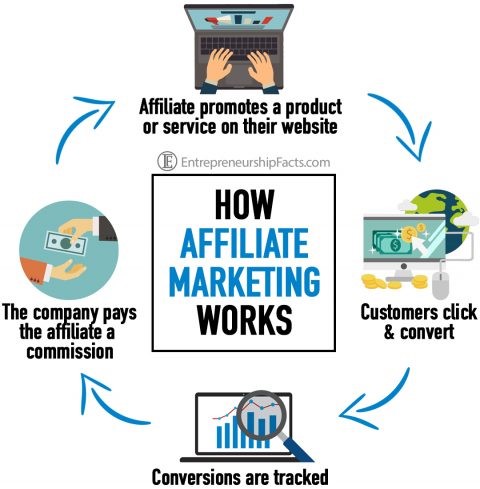Well into 2022, affiliate marketing is far from an innovative form of marketing. This digital marketing staple has practically existed for nearly as long as the internet has, in only slightly different forms. In its lifetime, it has established itself as a very effective, low-risk endeavor and holds massive appeal across most industries. It’s such a prominent mainstay, in fact, that even such juggernauts as eBay and such platforms as Forbes use it.
The global pandemic has not halted its growth either. On the contrary, it has seemingly accelerated its appeal. For individuals, it offers a new way to earn passive income in pressing times. For businesses, it provides a low-risk way to expand their reach and hit their revenue goals despite adversity. Having mentioned eBay, this is now particularly true for eCommerce affiliate marketing.
But what exactly is it, and which industry-specific benefits can eCommerce expect from it? Let us explore the issue in this article, as we illustrate why every eCommerce business needs affiliate marketing.
What is affiliate marketing?
First, let us briefly define this form of marketing.
As we’ve covered in past articles, affiliate marketing is simple enough – it’s a collaboration between brands and third-party marketers (publishers). In this arrangement, the publisher promotes the brand’s products or services and gets a commission fee for each agreed milestone. Milestones are typically successful conversions, but not exclusively so – as we’ll discuss next.

Needless to say, this arrangement is beneficial to both sides. The brand gets increased exposure, more conversions, or other campaign-specific benefits. The publisher receives a commission which can end up generating generous passive income.
Finally, the customer sees no additional fees of any kind either. On the contrary, they may often be enticed to complete a purchase because of the commission fee; a part of their purchase will support their trusted content creators or publishers. That is to say, disclosures of affiliate marketing links won’t typically discourage customers but only further encourage them.
Types of affiliate marketing
That said, there are many types of affiliate marketing. One may typically divide them into types based on two criteria; the commission structure and the publisher’s content.
Commission structure types
Starting with the former, there are three main types of affiliate marketing based on commission structures.

#1 Purchase-based
Perhaps the most common type, and the one that sees the most use in eCommerce affiliate marketing, this one has the publisher receive their fee on successful purchases. As with other types, the brand tracks this through codes the customers use on their website.
Among the three types, this one targets new customers the least. Exposure does help, of course, but is not inherently required. Instead, on the brand’s side, it lets you work with what you have, enticing existing customers into more purchases no less than new ones.
#2 Traffic-based
Another relatively common type, this one has the publisher receive their fee based on successful traffic generation. What the brand track, in this case, is raw visit numbers, regardless of completed purchases or other actions.
This type typically targets new customers the most and seeks to drive lead generation and brand awareness campaigns. It does cost relatively more for brands, as customers haven’t yet taken any actions that do or can generate revenue. However, it’s among the more realistic goals for new and expanding businesses when conversions might lag behind.
#3 Acquisition-based
The third main type, too, is fairly common in eCommerce affiliate marketing contexts. In it, the brand pays for customer acquisitions, new signups, new unique buyers, or however else their campaigns define the acquisition.
Like traffic-based structures, this one too primarily targets the new customer. It does not primarily hinge on immediate revenue gains through more conversions but on more customer acquisitions for long-term revenue.
Publisher types
Regarding the latter, one may also distinguish among affiliate marketing types based on publisher content. Those subtypes are more numerous, so we may consolidate the primary ones here.

#1 Visual content creators
This type of content remains immensely popular despite the pandemic. In fact, Wyzowl’s video marketing statistics paint a very bright image for the future. Among others, consider the following:
- “Video continues to be used by an overwhelming majority of businesses[;] 86% of businesses use video as a marketing tool.”
- “A huge proportion of marketers (92%) continue to value video as an ‘important part’ of their marketing strategy.”
- “64% of marketers say their video marketing plans for 2021 and 2022 have been affected by the pandemic. Out of these people, three-quarters said the pandemic made it more likely they would create video, and the other quarter said it made it less likely.”
Those numbers should encourage video marketing as a standalone channel and as one ripe for eCommerce affiliate marketing. Such content creators typically enjoy ample trust from their audiences, facilitating the psychological phenomenon described above. Even if it doesn’t, their engagement rates alone serve as a reason why every eCommerce business needs affiliate marketing.
#2 Social media influencers
The influencer marketing industry also continues to thrive on the subject of engagement rates. In the context of affiliate marketing, it’s notable that smaller influencers still offer better engagement rates – and thus better conversion rates.
The overlap between the two industries has now culminated into what marketers dub “social commerce”. To demonstrate the increasing overlap between influencer marketing and eCommerce, we may cite IMH’s 2022 report:
- “54% of the firms working with influencers operate eCommerce stores.”
- “The value of social commerce sales in 2022 is estimated to be $958 billion.”
- “By 2025, social commerce is expected to account for 17% of all eCommerce spending.”
This is effectively, by all means, another form of influencer marketing as well. It thus requires a robust social media presence and comes with its own risks, including influencer fraud. It also fuses the benefits of influencer marketing with those of affiliate marketing, with demonstrable long-lasting appeal.
#3 Bloggers and email marketers
Finally, this subset consolidates traditional affiliate marketing publisher types for text economy. We may separate bloggers from the rest to untangle them a bit for clarity.
Bloggers likely offer the most recognizable form of eCommerce affiliate marketing today. If their Search Engine Optimization (SEO) practices are robust, they capitalize on search engine visibility to earn their traffic. In turn, they promote brands’ products and services in relevant articles, such as listicles and comparison articles. This formula works so well that almost 65% of all affiliate marketers today generate traffic via blogging.
Like news publications and review websites, other publishers will often have large email lists you may work with instead. This type of affiliate marketing sees a fusion with email marketing, where links are delivered to customers’ inboxes. This does break away from the traditionally inbound style of affiliate marketing but remains highly effective nonetheless. Given that recipients have opted into receiving emails, it enjoys comparable Return on Investment (ROI) to the two standalone channels.
Why every eCommerce business needs affiliate marketing
Having established what affiliate marketing is and having noted its primary advantages in passing, here, we may delve deeper. Should you need deeper insights into affiliate marketing, you may consult our article on getting started with affiliate marketing.

Alt-tag: A miniature shopping cart and bags and boxes on a silver laptop.
In no particular order, here are the top reasons why eCommerce brands may strongly consider this marketing channel.
#1 Immense ROI
Perhaps most importantly, before all else, eCommerce affiliate marketing offers undeniably high ROI. Equally notably, it offers controllable ROI; commissions will vary from 1 to 10% and will thus directly affect final returns.
First, to quantify its effect on the eCommerce industry, consider the following statistics:
- “The affiliate industry is responsible for a total of 16% of online orders.”
- “Affiliate marketing is responsible for 16% of global eCommerce sales.”
- “73% of merchants believe affiliate marketing programs meet their revenue expectations.”
- “65% of merchants report an annual affiliate marketing revenue of up to 20%.”
- “86% of publishers expect their affiliate marketing revenue to stay consistent or increase in the future.”
While those may offer some initial reassurance, CJ Affiliate’s Insights delve deeper into revenue gains specifically:
- Customer acquisitions completed through affiliate referrals showcase a 58% higher average customer revenue (ACR).
- Affiliate referrals yield orders that are 31% higher compared to the customer order average (COA).
- Affiliate referral customers showcase a 21% higher average order value (AOV).
Combined, the two should make a strong case for it. ROI should, of course, account for total costs and total returns, but, strictly on individual transactions, the highest commission fees of 10% still leave an effective ROI of 10:1.
#2 Hyper-specific goals
In addition, eCommerce affiliate marketing offers excellent flexibility as regards campaign goals. Almost every eCommerce business needs affiliate marketing in this sense, as it may serve all common growth goals.
As highlighted above in commission structure types, different forms of affiliate marketing can serve different purposes. Namely, the three types above roughly equate to the three most common ones, split among the three customer journey phases.
Lead generation.
In the discovery phase goal, traffic-based campaigns seek to generate traffic primarily. Publishers get their fees on successful traffic generation because, at this point, the brand prioritizes lead generation. These campaigns often rely on bloggers leveraging their own SEO and influencers, seeking to raise awareness with new audiences.
Lead acquisition.
The consideration phase goal, acquisition-based campaigns, will focus on acquiring new leads and prospects. Under customer acquisition-based structures, publishers get paid for new signups and new customers. Such campaigns might also rely on bloggers and influencers or other publishers with access to a somewhat engaged audience.
Conversion.
The most traditional purchase-based structure’s final decision phase seeks to secure conversions and sales. This prominent structure has publishers get a fee for completed sales and is the one that directly drives higher revenues. Any publisher type may serve such campaigns as long as their audiences have enough purchase intent to fuel them.
#3 Tracking performance
For that matter, eCommerce affiliate marketing offers excellent trackability through easily monitored Key Performance Indicators (KPIs). Depending on your campaign goals, you may set specific KPIs against which you can swiftly measure your efforts’ performance.

Among many, consider the following substantive ones.
Revenue.
The primary KPI for many, revenue, is the primary metric to track for all campaigns except for lead generation ones. It’s the one that Evan Porter finds overshadows “other trivial data points”, as it directly reflects final gains.
This KPI is informed by peripheral factors like traffic, engagement, and conversion rates. Those metrics may well inform publishers on enhancing their final revenue gains. But by itself, this KPI is among the most crucial ones to track – and thankfully easy to follow as well.
Clicks and earnings per click (EPC).
Another straightforward KPI is clicks. By themselves, clicks serve as a robust overview of a given link’s effectiveness. They can measure exposure and, if misaligned with conversion rates and revenue, can quickly highlight issues beyond basic exposure.
However, some consider them a vanity metric, so they opt for EPC instead. As the name suggests, this KPI divides earnings by clicks to deduce average earnings per click. This metric is valuable as well, as it can reveal disparities between clicks and revenue. For brands, EPC offers a more reliable KPI to choose publishers through than clicks alone, as it better informs revenue.
Affiliate engagement.
A broader KPI, this one includes a few different metrics one can prioritize depending on their eCommerce affiliate marketing goals. Namely:
- Visits
- Referrals
- Conversions
The sum of these metrics makes up affiliate engagement, which can also serve as an excellent publisher grading tool. Brands may track these concurrently through link analytics and deduce which publishers best fit their goals.
Customer lifetime value (LTV).
Another specific KPI, LTV measures a customer’s total value to a brand throughout their lifetime. This notable metric can augment initial ROI evaluations; if initial customer acquisition costs exceed the first-order value, but LTV exceeds acquisition costs, then the customer in question still offers a net positive revenue outcome.
Granted, this KPI is harder to track than most, and LTV can also be affected by non-publisher factors like UX. However, as highlighted above, referral customers typically yield a higher ACR, which will typically overlap with higher LTV.
Average order value (AOV).
Finally, another KPI that referral customers excel at is AOV. This metric you may calculate by dividing revenue by the number of orders to deduce a customer’s average order value.
This KPI can serve many purposes in itself, including gauging customer behaviors and evaluating publisher efficiency. It directly measures profitability and can even be used as a reference point for price brackets.

#4 Business scaling
Because of the above benefits, eCommerce affiliate marketing lets brands scale their business efficiently. It serves all three customer journey phases, as highlighted above, and thus allows for exponential business growth. With notable competition persisting into 2022, every eCommerce business needs affiliate marketing in this regard.
Citing the above statistics again, we may offer three main suggestions in this regard:
- Diversify your reach. With so many options, it’s typically effective to expand across different publisher types, from influencers to news publications and more.
- Use different commission structures. Depending on your priorities and chosen publisher types, it typically works best to establish different structures in line with your goals to incentivize better performance.
- Work with multiple publishers. Regardless of either publisher type or commission structure, most eCommerce brands don’t work with fewer than four publishers at once.
These suggestions are, of course, somewhat subjective, so you may best approach them on a case-by-case basis. What works for one brand may not work for another, so your own analytics will always be your best consultant.

#5 Social proof
Perhaps the simplest benefit of affiliate marketing, in general, lies in social proof. In effect, all affiliate marketing serves as an endorsement by publishers your customers typically view as their peers. While not too substantive on its own, social proof is highly effective in driving sales. And naturally, eCommerce affiliate marketing values the KPI of revenue quite highly.
To substantiate this claim, consider such statistics as the following:
- 61% of consumers trust the recommendations of influencers, while only 38% trust branded social media content.
- Over 90% of all online consumers consult reviews before making a purchase.
- Almost 70% of all consumers’ buying decisions are influenced by peer recommendations.
In an era of general customer mistrust and changed customer behaviors, publishers of all types serve to humanize brands. Their endorsement directly inspires trust, the exact effectiveness of which can always be measured through the above KPIs.

#6 SEO benefits
Another notable benefit lies in SEO enhancements. This is particularly true for traffic-based campaigns or campaigns that don’t exclusively seek to drive revenue. This benefit is twofold, spanning across immediate and potential SEO gains.
As regards the former, engaged traffic will boost your website’s own traffic and engagement signals – especially if you have a robust content marketing strategy in place yourself. Those are ranking factors in themselves, so boosting them enhances your SEO score. This newfound visibility will then attract more visitors and engagement, fueling SEO further.

The latter includes opportunities for SEO strategies. Most notably, working with content creator publishers presents the opportunity for mutual backlinks and mutual content contributions. How exactly you leverage such options will strictly depend on your website’s SEO foundations, but it remains a notable benefit.
#7 Differentiation from the competition
Finally, eCommerce affiliate marketing offers substantial differentiation from your competition as a closing benefit. As the aforecited statistics show, the eCommerce industry does see increased competition, so differentiation becomes a crucial component to success.

In this regard, every new publisher’s voice and content effectively becomes a branding nod. The sum of their outreach shapes your own identity, letting you carve your own unique niche and reach unique audiences. It may not ensure success alone, but it certainly helps to enjoy some differentiation in this sense. What’s more, you may do so with no additional effort; their content adds value to your offerings without your intervention.
Conclusion
To summarize, there are many reasons why every eCommerce business needs affiliate marketing in 2022. The industry remains competitive, and affiliate marketing offers ample room for diversification. It offers consistently high ROI, customizability to fit specific goals, and ample KPIs to readily measure performance. It effectively acts as additional social proof, and it even presents opportunities for SEO and content strategy enhancements. All in all, affiliate marketing is a reliable way to facilitate business scaling, with few risks and many benefits. If you have not considered it yet, 2022 may be the best year to do so.
About the author
John Blake is a freelance blogger and avid SEO practitioner. Over the past decade, he has primarily authored content on SEO, PPC, and affiliate marketing, with a strong focus on the AEC and eCommerce industries.





